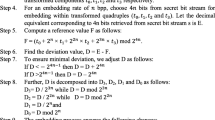Abstract
In this work, authors propose an approach for securing binary images. The proposed method is a two step technique based on visual cryptography scheme (VCS) and integer-to-integer wavelet transform techniques. First, two meaningless shares, master and ownership share are extracted from the binary image using (2,2)-random grid based VCS. Next, the master share is embedded into a cover image using reversible integer-to-integer wavelet transform providing a two-tier security to the binary message. The performance is analyzed by calculating peak signal to noise ratio (PSNR), mean square error (MSE) and cross-correlation coefficient (Rxy). Simulation results are also discussed for the cases when discrete cosine (DCT) and discrete wavelet transforms (DWT) are used in the second step.










Similar content being viewed by others
Abbreviations
- VCS:
-
Visual cryptography scheme
- DCT:
-
Discrete cosine transform
- PSNR:
-
Peak signal to noise ratio
- Rxy:
-
Cross-correlation coefficient
- DWT:
-
Discrete wavelet transform
- MSE:
-
Mean square error
References
Naor M, Shamir A (1995) “Visual cryptography,” advances in cryptology-EUROCRYPT’94, LNCS 950. Springer-Verlag, Berlin, pp 1–12
Yang CN (2004) New visual secret sharing schemes using probabilistic method. Pattern Recogn Lett 25(4):481–494
Shyu SJ (2007) Image encryption by random grids. Pattern Recogn 40(3):1014–1031
Chen TH, Tsao KH (2011) User-friendly random-grid-based visual secret sharing. IEEE Trans Circuits Syst Video Technol 21(11):1693–1703
Hou YC, Wei SC, Lin CY (2014) Random-grid-based visual cryptography schemes. IEEE Trans Circuits Syst Video Technol 24(5):733–744
Joseph SK, Ramesh R (2015) Random grid based visual cryptography using a common share. In: international conference on computing and network communications (CoCoNet), Trivandrum, pp. 656–662
Dang PP, Chau PM (2002) Integer fast wavelet transform and its VLSI implementation for low power applications. In: IEEE workshop on signal processing systems, pp. 93–98
Reichel J, Menegaz G, Nadenau MJ, Kunt M (2001) Integer wavelet transform for embedded lossy to lossless image compression. IEEE Trans Image Process 10(3):383–392
Yongqiang C, Hanping H (2010) Gray image watermark algorithm in integer wavelet transform domain. In: international conference on electrical and control engineering (ICECE), Wuhan, pp. 1096–1099
Hsu CT, Wu JL (1999) Hidden digital watermarks in images. IEEE Trans Image Process 8(1):58–68
Hsu CT, Wu JL (1998) DCT-based watermarking for video. IEEE Trans Consum Electron 44(1):206–216
Barni M, Bartolini F, Cappellini V, Piva A (1998) A DCT-Domain system for robust image watermarking. Signal Process 66:357–372
Kunhu A, Nisi K, Sabnam S, Majida A, Al Mansoori S (2016) Hybrid visual cryptography cum watermarking algorithm for copyright protection of images 2016. In: online international conference on green engineering and technologies (IC-GET), Coimbatore, India, pp. 1–5
Kester QA, Nana L, Pascu AC, Gire S, Eghan JM, Quaynor NN (2015) A novel hybrid discrete cosine transformation and visual cryptographic technique for securing digital images. In: 2015 17th UKSim-AMSS international conference on modelling and simulation (UKSim), Cambridge, pp. 327–332
Shivani S (2017) VMVC: verifiable multi-tone visual cryptography. In: Multimedia Tools and Applications, pp. 1–20
Shivani S, Agarwal S (2016) VPVC: verifiable progressive visual cryptography. In: Pattern Analysis and Applications, pp. 1–28
Abdullah MAM, Dlay SS, Woo WL, Chambers JA (2016) A framework for iris biometrics protection: a marriage between watermarking and visual cryptography. IEEE Access 4:10180–10193
Li P, Yang C-N, Kong Q (2016) A novel two-in-one image secret sharing scheme based on perfect black visual cryptography. J Real-Time Image Process. 1–10. doi:10.1007/s11554-016-0621-z
Author information
Authors and Affiliations
Corresponding author
Rights and permissions
About this article
Cite this article
Tulsani, H., Chawla, P. & Gupta, R. A novel steganographic model for securing binary images. Int. j. inf. tecnol. 9, 273–280 (2017). https://doi.org/10.1007/s41870-017-0031-x
Received:
Accepted:
Published:
Issue Date:
DOI: https://doi.org/10.1007/s41870-017-0031-x




